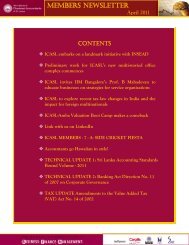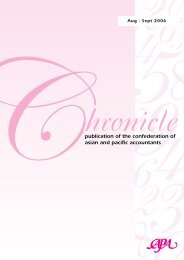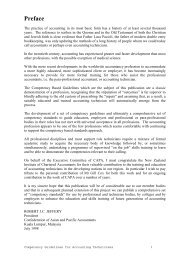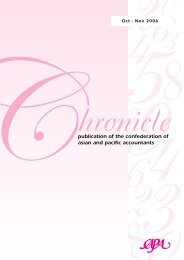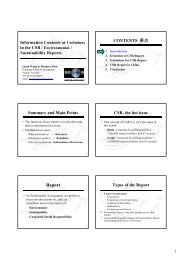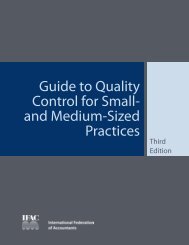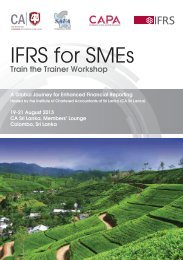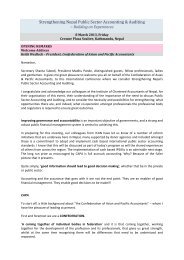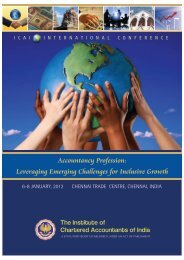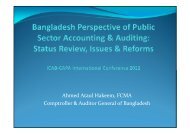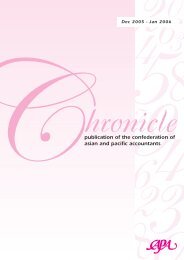Chapter 5. Summary - Confederation of Asian and Pacific Accountants
Chapter 5. Summary - Confederation of Asian and Pacific Accountants
Chapter 5. Summary - Confederation of Asian and Pacific Accountants
Create successful ePaper yourself
Turn your PDF publications into a flip-book with our unique Google optimized e-Paper software.
<strong>5.</strong> <strong>Summary</strong><br />
The objective <strong>of</strong> this study was to examine the extent to which accounting<br />
st<strong>and</strong>ards <strong>of</strong> selected East <strong>Asian</strong> countries are consistent with IASs <strong>and</strong> the<br />
extent to which practices <strong>of</strong> selected East <strong>Asian</strong> companies conform to the<br />
requirements <strong>of</strong> IASs. This study complements a similar study <strong>of</strong> compliance<br />
by Rahman (1998) to evaluate the “lessons learned” since the East <strong>Asian</strong><br />
crisis.<br />
This study identified a number <strong>of</strong> cases where the requirements <strong>of</strong> IASs had<br />
been adopted prior to adoption in the domestic accounting st<strong>and</strong>ards, that is,<br />
de facto harmonisation. We observe preparers <strong>of</strong> accounting information<br />
increasing the level <strong>of</strong> voluntary disclosures in line with IASs where domestic<br />
regulation does not meet market expectations. Such a reaction is consistent<br />
with the findings <strong>of</strong> Mitton (2002) that firms with higher disclosure quality<br />
experienced significantly better stock price performance during the East <strong>Asian</strong><br />
crisis. Firm-specific corporate governance initiatives augment country-specific<br />
responses to the East <strong>Asian</strong> crisis.<br />
While the level <strong>of</strong> overall observance <strong>of</strong> <strong>and</strong> compliance with IASs reported in<br />
this study exceeds that reported in Rahman (1998), reporting practices vary<br />
markedly between countries within the sample. Care should be exercised,<br />
however, in drawing conclusions on an individual country or regional basis<br />
given disparate sample sizes <strong>and</strong> sample selection.<br />
Lessons Learned<br />
Convergence <strong>of</strong> domestic st<strong>and</strong>ards with IASs contributes to de jure<br />
harmonisation. Individual countries in the region have varying rates <strong>of</strong><br />
convergence with each making substantive progress towards adoption <strong>of</strong> high<br />
quality, global accounting st<strong>and</strong>ards. Attention should now also be directed to<br />
the application <strong>of</strong> accounting st<strong>and</strong>ards. Two related issues beyond the scope<br />
<strong>of</strong> this study but nevertheless worthy <strong>of</strong> comment are the interpretation <strong>and</strong><br />
enforcement <strong>of</strong> accounting st<strong>and</strong>ards.<br />
For countries used to writing accounting regulation as highly detailed rules,<br />
the movement to IASs based on principles may allow more discretion in<br />
application, increasing the dem<strong>and</strong> for a country-specific interpretation.<br />
Although the International Accounting St<strong>and</strong>ards Board provides<br />
Interpretations <strong>of</strong> International Accounting St<strong>and</strong>ards issued by the St<strong>and</strong>ing<br />
Interpretations Committee they are not developed as explicit rules covering<br />
every conceivable circumstance. Measuring harmonisation in such<br />
circumstances becomes increasingly problematic. From an investor<br />
perspective, greater transparency should assist the efficient functioning <strong>of</strong><br />
capital markets.<br />
Second, the reporting environment is also a function <strong>of</strong> the effectiveness <strong>of</strong><br />
the mechanisms for monitoring accounting practices. Compliance issues<br />
include the regulatory status <strong>of</strong> accounting st<strong>and</strong>ards <strong>and</strong> the roles <strong>and</strong><br />
responsibilities <strong>of</strong> the pr<strong>of</strong>ession vis a vis corporate <strong>and</strong> security regulators.<br />
Accounting education <strong>and</strong> training are pivotal to the efficient operation <strong>of</strong><br />
capital markets. Moreover, concurrent acceptance <strong>of</strong> IASs <strong>and</strong> domestic
st<strong>and</strong>ards may severely challenge the resources <strong>of</strong> the pr<strong>of</strong>ession <strong>and</strong><br />
domestic security regulators. In short, the speed <strong>of</strong> harmonisation towards<br />
IASs should match the stage <strong>of</strong> development <strong>of</strong> each country’s pr<strong>of</strong>essional<br />
<strong>and</strong> regulatory institutions.<br />
There is also scope for a regional response to harmonisation in East Asia.<br />
The formation <strong>of</strong> a St<strong>and</strong>ards Advisory Council to the IASB provides for<br />
regional representatives to consult with the IASB on major policy decisions.<br />
The <strong>Confederation</strong> <strong>of</strong> <strong>Asian</strong> <strong>and</strong> <strong>Pacific</strong> <strong>Accountants</strong> is uniquely placed to<br />
focus attention on common issues arising from the “East <strong>Asian</strong> crisis” <strong>and</strong><br />
formulate an East <strong>Asian</strong> response. Collective initiatives are in addition to the<br />
firm <strong>and</strong> country-specific mechanisms referred to earlier to assist in restoring<br />
confidence in the region.




